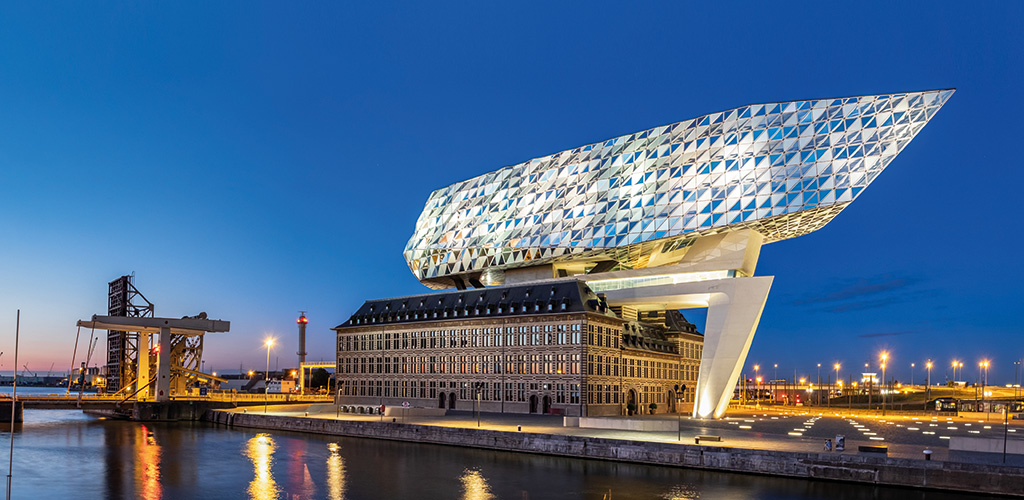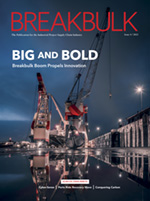Jun 23 | 2021
Rebound of Breakbulk Cargoes Welcomed

 By Felicity Landon
By Felicity LandonPre-2020, many traditional breakbulk ports were already grappling with the impact of trade and tariff wars, on top of the loss of breakbulk volumes in the drive to containerize pretty much anything. The pandemic delivered another layer of challenges, particularly as major projects were delayed or postponed and other breakbulk cargoes fell, together with the need to adjust to socially distanced, Covid-safe working practices.
Is there room for optimism now? It seems so. In the first three months of 2021, the Port of Antwerp’s breakbulk segment had its best quarter since the second quarter of 2019. Volumes of iron and steel, the port’s main breakbulk cargoes, increased by more than 18 percent. This was due to a peak in the supply of steel, which could be partly explained by the new import quotas that took effect on April 1, said marketing adviser Annick Dekeyser.
Steel volumes – dominated by coil – had been under pressure from mid-2019 due to several trade wars, she said. This was compounded by the arrival of Covid-19 bringing the automotive industry to a standstill, with steel volumes collapsing in April and May 2020. While there have been signs of a pickup in vehicle production this year, nevertheless the industry has been held back by a shortage of microchips – yet another side effect that could hold back demand for steel.
Antwerp, which has 15 terminals specializing in project and breakbulk cargoes, is pushing forward on several levels. In January, the port appointed a representative in Russia. Based in Moscow, Andrey Daskovskiy is focusing particularly on steel and project cargo. “Russia is one of our top five maritime partner countries, so appointing a local representative is a next step in broadening our international network by connecting more closely to the Russian market,” Dekeyser said. “All our representatives plan their activities in the framework of our commercial strategy, of which breakbulk is one of the six focus areas.” About 10 percent of Antwerp’s total steel volume is to/from Russia, she added.
A marketing campaign which ran to February this year sought to inform potential customers about what is possible in the Port of Antwerp in terms of handling steel: “We made movies focusing on different aspects of the service in the port, including warehousing possibilities and our hinterland connections by truck, train and barge. We spread the word through social media.”
Many companies ship a range of commodities, and it is possible they have not shipped steel for three or four years, so they are almost a “new” customer, Dekeyser pointed out. “They might not know that Antwerp can do these activities and is perfectly equipped – and they can, of course forget about you. So, the task is to keep being visible, not only in Europe but in steel producing countries like China, India, Russia and the U.S.”
Platform Pilot
The campaign also publicized Bulkchain, a digital platform for breakbulk cargoes developed by the Port of Antwerp’s NxtPort subsidiary. A pilot with ArcelorMittal last year examined how Bulkchain could create more transparency and efficiency on the terminal, and the aim now is to get all players onboard, Dekeyser said. “The pilot confirmed many benefits for Acelor’s business. To name just a few – one platform for all stakeholders, efficient yard planning, standardized product references, integration with own software, more transparency thanks to real-time updates, increased efficiency and reduction of paperwork. We see several port companies in Antwerp starting to use the platform, because they recognize those benefits.”
Bulkchain can be used for all breakbulk exports. The next developments will focus on import cargoes, scheduled to be included by the end of 2021.
A specific project cargo campaign will follow in the autumn this year. “We attribute great importance to project cargo, since a lot of employment and expertise is involved with the handling and shipment of project cargo,” Dekeyser said.
Antwerp’s huge petrochemical cluster is expected to generate a stream of project cargoes, thanks to some major expansions and refurbishments. Among the highlights last year, a large module was brought in through the port for Borealis, while a 1,000-tonne autoclave measuring 50 meters by 8 meters was loaded out of Antwerp for shipment to Russia.
In the Port of Hamburg, heavy-lift, project and non-containerized breakbulk account for barely 1 percent of cargo volumes these days. As Axel Mattern, CEO of Hamburg Port Marketing, said: “Everything that can go into containers does go into containers.”
A few years ago, the shipment of a large transformer or generator, accompanied by a range of “normal” breakbulk cargo, was the norm – that is no longer the case, as all but the largest pieces are containerized, he said. “That is not so easy for the liner operators, because they need volume as well.”
Nevertheless, Hamburg handles a steady stream of heavy-lift and project cargo – ranging from gas turbines from Siemens in Berlin to generators, transformers and other power production components, railway equipment and track-laying locomotives, mining trucks, ship’s propellers and brewery equipment. Barge access is an important advantage, providing access to and from the port without limits, Mattern said.
“At the end of the day it is the only transport mode left remaining which is easy to be used for heavy and big cargoes. When I was working for a heavy-lift terminal in Hamburg several years ago, we received 100 to 150-tonne pieces by road on a regular basis. You won’t see that on the streets anymore.
“We talk to the producers of heavy equipment and it is a problem in Europe because infrastructure must be modernized. For example, many bridges in western Germany are blocked for heavy truck loads. This is sometimes a signal for the industry to look for other production places in other regions.”
Nearshoring Welcomed
However, in the post-Covid era of rocketing container rates and a desire for resilience and shorter supply chains, another shift could deliver new project cargo flows for Hamburg. Manufacturers are looking to relocate production of consumer goods from Asia to countries such as Poland, Romania, Hungary and Bulgaria.
“This is something that is happening already and as we continue with these high prices of container transport, I am sure it will be a continuing trend,” Mattern said. “Look at what you paid for a container from China to Poland 18 months ago – US$1,000 maybe. Now we are at US$14,000 or US$15,000, and that will have an impact.
What we see moving first is furniture, because it is a space-consuming cargo and you can easily move production. It may be a little bit more expensive, but you are very close to your markets, quality control is easier, and there is the resilience issue.”
Of course, finished consumer items produced in Europe would no longer be imported through Hamburg. But new factories would be needed and the components for these could well be imported as project cargo.
Tesla’s mega factory being built close to Berlin is also of particular interest to Hamburg. “It is a greenfield project and completely changing the surroundings,” Mattern said. “While the batteries will be imported from Asia, the industry is looking to build battery production facilities in Germany as well and we are looking at a whole new industry building up. For all of this, they will need to bring cargo in.”
Meanwhile, could the high container rates lead to “decontainerization” of some breakbulk cargoes? There seems to be some anecdotal evidence in support of this. Mattern said that when container rates were low, large amounts of fertilizer were moved through Hamburg to the Far East and elsewhere in containers. “Now it is back to bulk business, because of the high rates and because there are not enough containers in the market.”
Opportunities in Houston
The Port of Houston may be experiencing something similar. Lisa Ashley, public relations director, noted that the port is seeing more ships carrying plywood, which is something it hasn’t seen in a while.
Within Port Houston’s complex of 200 private and eight public terminals along the 52-mile Houston Ship Channel is the largest general cargo/breakbulk terminal in the U.S.
“Port Houston Turning Basin City Docks public terminal is the national leader for breakbulk cargo, in part due to the large laydown areas located adjacent to the general cargo and heavy-lift docks,” Ashley said. “Project and heavy-lift cargo that moves through Port Houston City Docks support the petroleum and petrochemical industry in either their upstream or downstream production activities.
“We are continuously investing and exploring new opportunities to add acreage and densify our facilities to support increased volumes in breakbulk, project and heavy-lift cargo. For example, over the next couple of years, several of our wharves will receive structural concrete repair, fender replacement and geotechnical rehabilitation.”
In May, Port Houston reported that its multipurpose facilities “demonstrated strength,” notably with steel imports up 15 percent in April and up 6 percent year-to-date. This was the second month in a row for steel increases, indicating the highly anticipated rebound in this sector, it said.
“Texas leads the U.S. in the production of wind energy, and wind turbine activity has seen considerable growth as new energy-related cargo unfolds,” Ashley said. “Port Houston has seen this increase in activity across its docks, along with handling a host of breakbulk cargo like pipe and wind equipment.” Tube bundles and other project cargo including wind power equipment is up significantly, she added.
Meanwhile, the Houston Ship Channel Expansion is moving ahead, after it was awarded a “new start” designation in January and US$19.5 million in federal funds.
Work to prepare the first dredged materials deposit area is due to start soon, and oyster mitigation and the first channel dredging projects are expected to start in the fourth quarter. The schedule allows for three to four years to complete priority segments, which cover most of the length of the channel, with remaining segments to follow.
Felicity Landon is an award-winning freelance journalist specializing in the ports, shipping, transport and logistics sectors.
Image credit: Shutterstock


